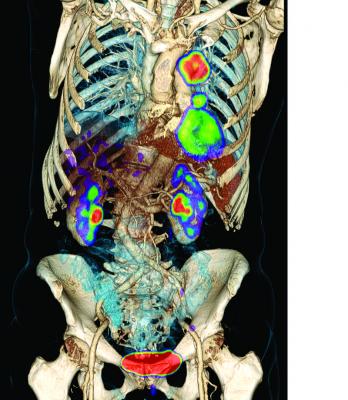
March 13, 2017 — FDG positron emission tomography/computed tomography (PET/CT) is a valuable imaging tool for treatment assessment of patients with lung cancer, though systematic evidence for its comparative effectiveness with conventional imaging, such as chest CT, is still evolving, according to a new study.
Authors of the study titled "The Value of FDG PET/CT in Treatment Response Assessment, Follow-Up, and Surveillance of Lung Cancer" published their findings in the February 2017 issue of the American Journal of Roentgenology.
In this review, the authors summarized the existing evidence in the literature concerning use of PET/CT for both assessing the efficacy of treatment response and performing post-treatment follow-up of lung cancer.
"FDG PET/CT is most useful when there is clinical suspicion or other evidence for disease recurrence or metastases," said study coauthor Rathan M. Subramaniam, of the department of radiology, University of Texas Southwestern Medical Center, Dallas. "Using FDG PET/CT for routine surveillance without any clinical suspicion should be discouraged until its value for patient survival outcomes is fully established."
The National Comprehensive Cancer Network (NCCN) recommends the use of FDG PET/CT for appropriately staging lung cancer and avoiding futile thoracotomies. It also recommends the imaging for accurate radiation therapy (RT) planning for both non-small cell lung cancer (NSCLC) and small cell lung cancer (SCLC). However, NCCN does not recommend routine use of FDG PET/CT for treatment response evaluation and follow-up in lung cancer.
According to the study authors, FDG PET/CT is usually recommended 12 weeks after completion of concurrent chemoradiation therapy to minimize radiation-related inflammatory uptake leading to false-positive studies. In some cases, radiation-related therapy changes, especially with stereotactic body radiotherapy, can last for many months. In these circumstances, a follow-up FDG PET/CT in three months is suggested to ensure resolution of therapy-related FDG uptake. FDG PET/CT can be performed four weeks after completion of chemotherapy or surgery (without concurrent radiation), because the therapy-related inflammatory uptake is less and subsides within a shorter time.
The sequencing, cost analysis and comparative effectiveness of FDG PET/CT and conventional imaging modalities in the follow-up setting need to be investigated.
Lung cancer remains the leading cause of cancer-related mortality worldwide, accounting for about 1.6 million deaths yearly. Despite significant advances in both diagnostic and therapeutic approaches, the overall five-year survival rate for lung cancer is 17.4 percent. However, this is largely dependent on the stage of diagnosis, with a survival rate of 54.8 percent for localized and 4.2 percent for disease that has metastasized in other parts of the body.
Lung cancer has historically been divided into two main types: NSCLC (85 percent of cases) and SCLC (10-15 percent of cases). A multidisciplinary approach including the use of advanced imaging techniques for early accurate staging of disease and delivery of treatment is needed to avoid futile treatments and improve overall survival, which, in turn, influence the patient's quality of life.
Surgery is usually the primary treatment modality for localized disease in patients with lung cancer. Even after curative surgery, patients remain at risk for the development of recurrence or a secondary pulmonary malignancy. Post-treatment follow-up usually consists of a combination of physical examination, laboratory tests and imaging. No single modality is simultaneously sensitive, specific and cost-effective; thus, a combined approach is needed for the detection of tumor recurrence.
PET is a noninvasive imaging modality that is promising in the evaluation of lung cancer and is currently used clinically for initial antitumor treatment strategy (for staging, treatment planning, and delivery of radiation treatment) and for subsequent antitumor treatment strategy (treatment response assessment and detection of recurrence in follow-up).
For more information: www.ajronline.org


 April 17, 2024
April 17, 2024 








